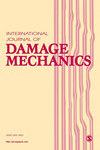压实石墨铁中基于损伤的裂纹萌生和扩展:真实形貌的数值策略比较
IF 3.9
2区 工程技术
Q2 MATERIALS SCIENCE, MULTIDISCIPLINARY
引用次数: 0
摘要
压实石墨铁(CGI)因其优异的浇注性和导热性而广泛应用于汽车发动机。尽管进行了广泛的研究,但其微观结构对断裂行为的影响尚未完全阐明。在这项工作中,比较了四种不同的损伤模型的真实和简化的形态。所建立的模型考虑了石墨颗粒形态和畴边界条件的影响。在扫描电镜下进行了原位拉伸试验,对裂纹路径和形貌进行了表征。然后,生成了捕捉实际微观组织形态的有限元模型,假设基体和石墨具有各向同性和延展性。采用Johnson-Cook损伤方案和黏结区单元模拟裂纹萌生。结果表明,蠕墨石墨颗粒的末端容易产生裂纹。此外,相邻石墨包裹体之间的小基体桥有利于高应力的集中,并且随着间距的减小,高应力的水平增加。模拟结果的验证基于现场实验数据。所建立的模型有助于理解CGI的力学和断裂行为。本文章由计算机程序翻译,如有差异,请以英文原文为准。
Damage-based initiation and growth of cracks in compacted graphite iron: Comparison of numerical strategies for realistic morphology
Compacted graphite iron (CGI) is widely used in automotive engines thanks to its excellent castability and thermal conductivity. Despite extensive research, the influence of its microstructure on the fracture behaviour has not been fully elucidated. In this work, four different damage models with realistic and simplified morphologies are compared. The developed models consider the effect of graphite-particle morphology and the domain’s boundary conditions. The crack path and morphology were characterised with in situ tensile tests inside a scanning electron microscope. Then, finite-element models capturing the actual microstructure morphology were generated, assuming isotropic and ductile properties for the matrix and graphite. Crack initiation was simulated employing the Johnson-Cook damage scheme and cohesive-zone elements. It was found that cracks tended to initiate at the ends of vermicular graphite particles. Besides, small matrix bridges between the neighbouring graphite inclusions facilitated the concentration of high stress, with its level increasing as the spacing decreased. Validation of simulations was based on in situ experimental data. The developed model could assist in the understanding of the mechanical and fracture behaviours of CGI.
求助全文
通过发布文献求助,成功后即可免费获取论文全文。
去求助
来源期刊

International Journal of Damage Mechanics
工程技术-材料科学:综合
CiteScore
8.70
自引率
26.20%
发文量
48
审稿时长
5.4 months
期刊介绍:
Featuring original, peer-reviewed papers by leading specialists from around the world, the International Journal of Damage Mechanics covers new developments in the science and engineering of fracture and damage mechanics.
Devoted to the prompt publication of original papers reporting the results of experimental or theoretical work on any aspect of research in the mechanics of fracture and damage assessment, the journal provides an effective mechanism to disseminate information not only within the research community but also between the reseach laboratory and industrial design department.
The journal also promotes and contributes to development of the concept of damage mechanics. This journal is a member of the Committee on Publication Ethics (COPE).
 求助内容:
求助内容: 应助结果提醒方式:
应助结果提醒方式:


